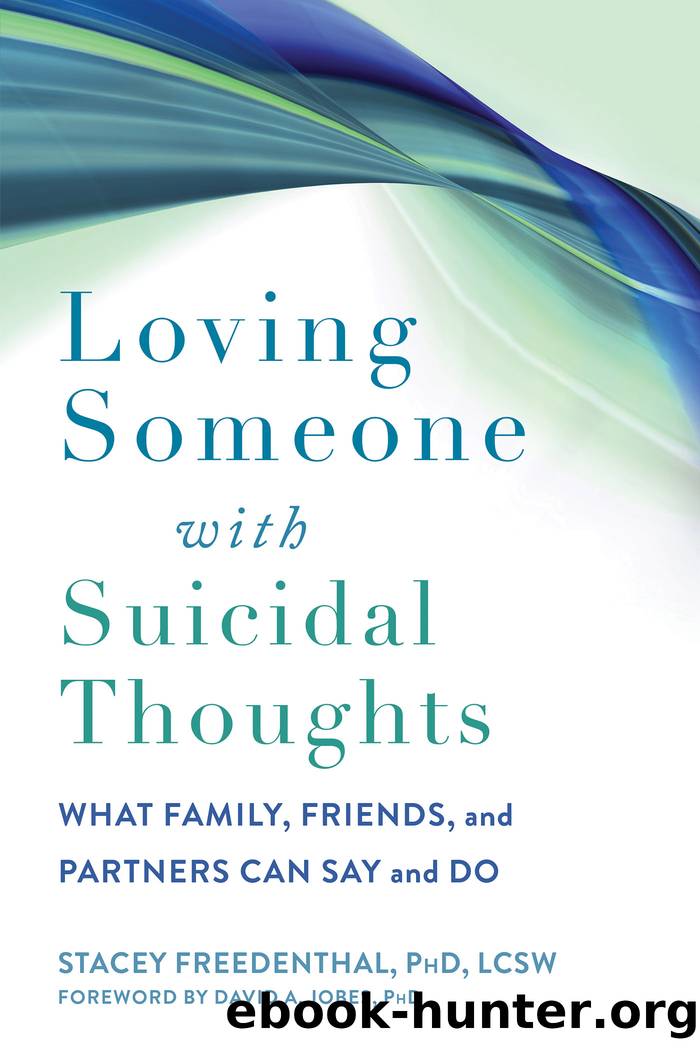Loving Someone with Suicidal Thoughts by Stacey Freedenthal

Author:Stacey Freedenthal
Language: eng
Format: epub
Publisher: New Harbinger Publications
Published: 2022-11-16T23:23:49+00:00
Where to Go in an Emergency
Hospital emergency rooms arenât just for heart attacks, strokes, and life-threatening injuries. Theyâre equipped to deal with psychiatric emergencies, too. Some cities also have walk-in crisis centers for mental health problems or specially designated psychiatric emergency services that are open twenty-four hours a day. Emergency rooms typically have a security guard or âsitterâ stay near someone whoâs waiting to be evaluated for suicidal thoughts, to prevent the person from leaving or attempting suicide. Some places are locked, so patients canât leave on their own accord. Someone with suicidal thoughts can go to an emergency room alone, come with a support person, or call 988 or 911 for emergency help.
Be prepared. Your loved one might wait hours for treatment in the emergency room. Consider writing in your journal now what you might need to bring to keep both of you occupied, just in case. Think of chargers for cell phones and other electronics, reading materials, snacks, bottles of water, and a comfortable jacket or sweaterâfor each of you. What else?
Another challenge: While most doctors, nurses, and other health care professionals treat suicidal patients with respect, some respond with hostility. In various studies, staff blame these negative reactions on overwork, burnout, feelings of helplessness, and fear of liability (OâKeeffe et al. 2021). Some health care professionals resent suicidal patients for trying to die when so many dying patients yearn to live. These attitudes can do harm to individuals with suicidal thoughts and their caregivers, as Estelleâs experience shows:
I took my son to the hospital after he attempted suicide. A doctor was giving him stitches and said, âIf you really want to die, do it right and save us the time.â I was horrified. Without even thinking, I said, âIf you really want to hurt people, get a different job.â The doctor apologized, but nothing could make my son un-hear what heâd said.
Estelle emphatically conveyed to her son that his suicidal thoughts were not his fault and, instead, were a medical problem deserving of respectful treatment. Rude, hurtful remarks typically reflect a health professionalâs ignorance of mental illness, stress, or other dynamics beyond a suicidal personâs control. This gap is the professionalâs flaw, not the patientâs.
Emergency rooms donât provide ongoing care. This visit is a chance for staff to assess your loved one, prescribe medications, andâhopefully, but it depends on the ERâcollaboratively create a safety plan and arrange an appointment with a mental health professional. Alternatively, if your loved one requires twenty-four-hour monitoring, the emergency room staff will arrange for psychiatric hospitalization.
Download
This site does not store any files on its server. We only index and link to content provided by other sites. Please contact the content providers to delete copyright contents if any and email us, we'll remove relevant links or contents immediately.
Spare by Prince Harry The Duke of Sussex(5072)
Machine Learning at Scale with H2O by Gregory Keys | David Whiting(4175)
Fairy Tale by Stephen King(3218)
Will by Will Smith(2790)
Hooked: A Dark, Contemporary Romance (Never After Series) by Emily McIntire(2496)
The Bullet Journal Method by Ryder Carroll(2484)
Rationality by Steven Pinker(2291)
Can't Hurt Me: Master Your Mind and Defy the Odds - Clean Edition by David Goggins(2225)
It Starts With Us (It Ends with Us #2) by Colleen Hoover(2196)
Friends, Lovers, and the Big Terrible Thing by Matthew Perry(2117)
The Becoming by Nora Roberts(2085)
Love on the Brain by Ali Hazelwood(1963)
The Strength In Our Scars by Bianca Sparacino(1776)
HBR's 10 Must Reads 2022 by Harvard Business Review(1776)
A Short History of War by Jeremy Black(1759)
Leviathan Falls (The Expanse Book 9) by James S. A. Corey(1647)
515945210 by Unknown(1599)
A Game of Thrones (The Illustrated Edition) by George R. R. Martin(1587)
Bewilderment by Richard Powers(1536)
